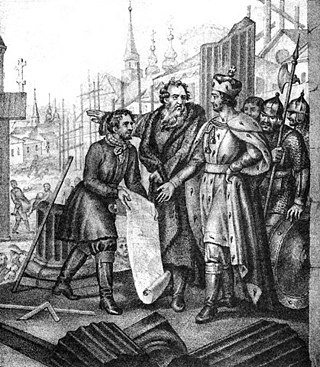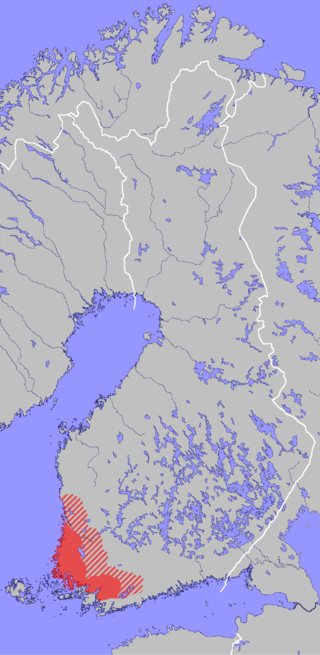
Porvoo is a city and a municipality in the Uusimaa region of Finland, situated on the southern coast about 35 kilometres (22 mi) east of the city border of Helsinki and about 50 kilometres (30 mi) from the city centre. Porvoo was one of the six medieval towns of Finland, along with Turku, Ulvila, Rauma, Naantali and Vyborg. It is first mentioned as a city in texts from the 14th century. Porvoo is the seat of the Swedish-speaking Diocese of Borgå of the Evangelical Lutheran Church of Finland. Porvoo was briefly the capital of the former Eastern Uusimaa region.
Finland's language strife was a major conflict in mid-19th century Finland. Both the Swedish and Finnish languages were commonly used in Finland at the time, associated with descendants of Swedish colonisation and leading to class tensions among the speakers of the different languages. It became acute in the mid-19th century. The competition was considered to have officially ended when Finnish gained official language status in 1863 and became equal to the Swedish language.

Ingria is a historical region in what is now northwestern European Russia. It lies along the southeastern shore of the Gulf of Finland, bordered by Lake Ladoga on the Karelian Isthmus in the north and by the River Narva on the border with Estonia in the west. The earliest known indigenous European peoples of the region are the now mostly Eastern Orthodox Izhorians and Votians, as well as the Ingrian Finns who descend from the Lutheran Finnish immigrants who settled in the area in the 17th century, when Finland proper and Ingria were both parts of the Swedish Empire.

Henry was a medieval English clergyman. He came to Sweden with Cardinal Nicholas Breakspeare in 1153 and was most likely designated to be the new Archbishop of Uppsala, but the independent church province of Sweden could only be established in 1164 after the civil war, and Henry would have been sent to organize the Church in Finland, where Christians had already existed for two centuries.

Karelia is a historical province of Finland, consisting of the modern-day regions of South Karelia and North Karelia. Historical Karelia also extends to the regions of Kymenlaakso, Northern Savonia and Southern Savonia (Mäntyharju).
Kvenland, known as Cwenland, Qwenland, Kænland, and similar terms in medieval sources, is an ancient name for an area in Fennoscandia and Scandinavia. Kvenland, in that or nearly that spelling, is known from an Old English account written in the 9th century, which used information provided by Norwegian adventurer and traveler Ohthere, and from Nordic sources, primarily Icelandic. A possible additional source was written in the modern-day area of Norway. All known Nordic sources date from the 12th and 13th centuries. Other possible references to Kvenland by other names and spellings are also discussed here.
Olaus Magnus was a Swedish writer, cartographer, and Catholic clergyman.

Finnish literature refers to literature written in Finland. During the European early Middle Ages, the earliest text in a Finnic language is the unique thirteenth-century Birch bark letter no. 292 from Novgorod. The text was written in Cyrillic and represented a dialect of Finnic language spoken in Russian Olonets region. The earliest texts in Finland were written in Swedish or Latin during the Finnish Middle Age. Finnish-language literature was slowly developing from the 16th century onwards, after written Finnish was established by the Bishop and Finnish Lutheran reformer Mikael Agricola (1510–1557). He translated the New Testament into Finnish in 1548.
Duke of Finland was an occasional medieval title granted as a tertiogeniture to the relatives of the King of Sweden between the 13th and 16th centuries. It included a duchy along with feudal customs, and often represented a veritably independent principality. Grand Duke of Finland was a nominal royal title used by Swedish monarchs from the 1580s until 1720, which was revived again briefly from 1802 to 1805 and was also used by Russia's monarchs until 1917.
Scandinavian literature or Nordic literature is the literature in the languages of the Nordic countries of Northern Europe. The Nordic countries include Denmark, Finland, Iceland, Norway, Sweden, and Scandinavia's associated autonomous territories. The majority of these nations and regions use North Germanic languages. Although the majority of Finns speak a Uralic language, Finnish history and literature are clearly interrelated with those of both Sweden and Norway who have shared control of various areas and who have substantial Sami populations/influences.

The Second Swedish Crusade was a possible 13th-century Swedish military expedition against the Tavastians, in present-day Finland, led by Birger Jarl. Many details of the Crusade are debated. After the crusade, Tavastia gradually started to fall under the rule of the Catholic Church and the Swedish kingdom.

There are scattered descriptions of early Finnish wars, conflicts involving the Finnish tribes, some of which took place before the Middle Ages. The earliest historical accounts of conflicts involving Finnish tribes, such as Tavastians, Karelians, Finns proper and Kvens, have survived in Icelandic sagas and in German, Norwegian, Danish and Russian chronicles as well as in Swedish legends and in Birch bark manuscripts. The most important sources are Novgorod First Chronicle, Primary Chronicle and Eric Chronicles.
Thomas is the first known bishop of Finland. Only a few facts are known about his life. He resigned in 1245 and died in Visby three years later.
Fulco was the first known missionary Bishop of Estonia. He was appointed in 1165 by Eskil, the Danish Archbishop of Lund. Before his appointment, Fulco was a Benedictine monk in the abbey of Moutier-la-Celle, near Troyes in France. His nationality is not known.

The Finnish–Novgorodian wars were a series of conflicts between Finnic tribes in eastern Fennoscandia and the Republic of Novgorod from the 11th or 12th century to the early 13th century.

In Swedish and Finnish history, Finland under Swedish rule is the historical period when the bulk of the area that later came to constitute Finland was an integral part of Sweden. The starting point of Swedish rule is uncertain and controversial. Historical evidence of the establishment of Swedish rule in Finland exists from the late 13th century onwards.

Finns proper are a historic people and a modern subgroup (heimo) of the Finnish people. They live in the areas of the historical province of Finland Proper and Satakunta, and they speak Southwestern dialects of Finnish. The Finns proper have had strong connections to Scandinavia throughout their history.

Ancient kings of Finland are kings of Finland mentioned in early historical sources. The word kuningas is an old Finnic word deriving from the ancient Germanic word kuningaz. In the time the sources were written, "Finland" mainly referred to the Finland Proper area, and depending on the source, the "kings of Finland" could also refer to kings of the Sami people.
The history of Finnish philosophy ranges from the prehistoric period to contemporary philosophy.

Johannes Wilhelm Öhquist was a Finnish civil servant, language teacher, art historian and politically active writer. He promoted cultural relations between Germany and Finland and disseminated information about Finland in German. He later sought to spread the idea of Nazism to Finland. Johannes Öhquist was the father of Lieutenant General Harald Öhquist.












